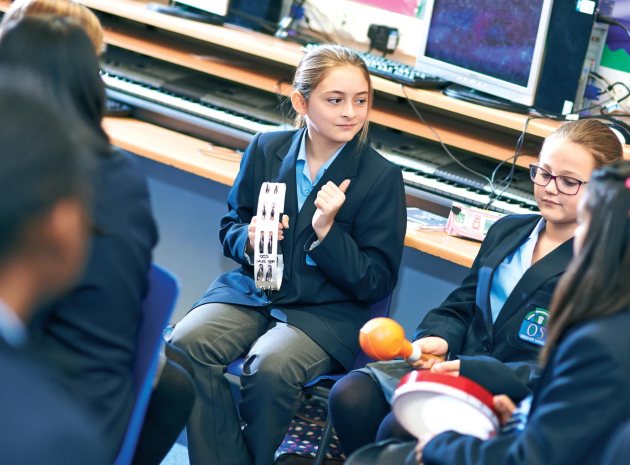I’ve heard some fantastic music lessons over the years. The music itself hasn’t always been wonderful but more often than not, the learning is clearly audible. Whereas you might ‘see’ learning in maths, history or science, you will ‘hear’ it in a music lesson. Whenever I’ve been in a non-music classroom, I’ve been able to look at pupils’ work and get a feeling for how much learning is taking place. With a music lesson, however, I can be outside the room and have a concrete idea of how much learning is taking place; it’s there to be heard in the music they make. That’s not to say that I don’t look at the pupils when observing a music lesson. I don’t use my eyes to see learning, however, I use them to see the look of sheer joy on pupils’ faces.
A good music lesson will see pupils actively involved in making music. Whereas many of us may recall our own music education being focused on writing about long-dead composers or trying to decipher musical notation, today’s lessons are much more hands on. Walk into your music department and you’re likely to find all manner of music making. Whole-class singing or instrumental work, small band work in practice rooms, music technology or any combination of the above.
Thanks to movements like Musical Futures, a tried-and-tested pedagogy for bringing informal learning practices into classrooms in order to engage every child in music learning, today’s music classroom is more likely to resemble the extra-curricular music of years passed.
This transformation of music making, its leap from lunch breaks to lessons, is why music contributes so much to the soul of a school. The experiences that once belonged to the lucky few who could join the orchestra are now open to every child. The sense of community, identity and collaboration previously accessed by those in the choir is now where music lessons start.
A question of value
In these times of austerity and having to make incredibly difficult decisions, it’s easy to look at the numbers and mistake music for a sensible place to make cuts. With a national average of 7% taking music at GCSE, it’s unlikely to grant you huge class sizes. And with the subject not contributing to the EBacc and not having the double-weighting of English and mathematics, it can be hard to justify the large classrooms and all those practice rooms on paper. The numbers on the page (or spreadsheet) will rarely add up in the same way as for other subjects. I can understand a head teacher asking the question “Why should music be an exception?”
Losing music as an option at Key Stage 4 is a decision that will have ramifications that trickle down to the younger year groups. Without GCSE or BTEC music pupils, it’s all but inevitable that extra-curricular participation will decline as the lack of upper school provision reduces the number of musical role models in the school. While the first hints of such a change might be glimpsed through a decline in the quality of ‘shop window’ music provided at open evenings and concerts, this isn’t the most important contribution that music makes to your school.
So, if you’re a head teacher who finds yourself being forced by funding cuts to ask this question, then please stand up from your desk and walk over to the music department. When you get there, you may be a little overwhelmed by the ‘noise’. So much music making in one place won’t often be comprehensible at first. Don’t jump to conclusions, listen for a while. Really listen. Find the subtle changes in the playing.
The timing that becomes more regular, the intonation that gradually becomes more precise and the detached stabbing at piano keys that slowly evolves into a lilting legato phrase. Once you’ve heard these things, then you can start using your eyes. How has the transformation of the music transformed the child? Which ‘problem pupils’ are intensely trying to master a drum riff? What was it about that melody that made the shy Year 8 boy smile?
And then ask yourself again: “Why should music be an exception?” Are these things that you want to cut?
Let’s keep music where it belongs – in the classroom.
About the author
John Kelleher is a Musical Futures Associate










